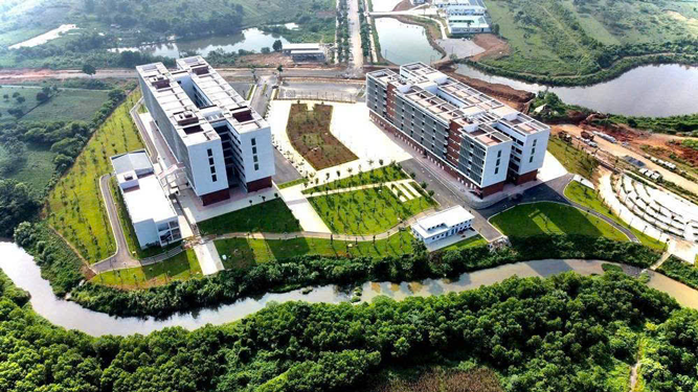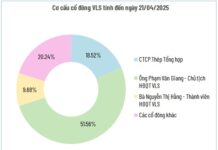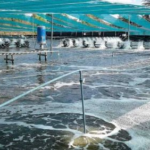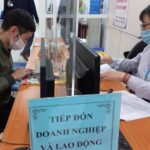On October 16, the wards of Ha Long and Bai Chay in Quang Ninh Province announced and issued decisions regarding the plan to reorganize public educational institutions within their areas. Previously, similar restructuring efforts had been completed in Dam Ha and Quang Tan communes.
Restructuring from Primary to University Levels
According to the Department of Education and Training (DOET) of Quang Ninh Province, prior to the merger, the province had 638 educational institutions ranging from preschool to university levels (including 56 private schools), catering to a total of 394,571 children, students, and trainees. The number of public educational institutions is expected to reduce by approximately 50%.
Following the guidelines for reorganizing preschool, general education, and continuing education networks to align with local authorities at two administrative levels, as outlined by the Ministry of Education and Training (MOET), preschool and general education institutions will only merge schools and campuses within the same commune-level administrative unit. Priority is given to retaining campuses with favorable conditions (infrastructure, transportation, and concentrated population). Standalone campuses that do not meet minimum infrastructure standards will be dissolved. Educational institutions subject to consolidation must ensure adequate infrastructure at the main campus.

Several universities are expected to merge with Hanoi National University. Photo: BUI TUAN
Many localities have also proposed plans to reorganize and merge public universities and colleges within their regions. Ha Tinh Province has suggested further studying the merger of Ha Tinh University into Hanoi National University or following new directives from the MOET. In Phu Tho Province, after restructuring, there will be one university, one medical college, and three vocational colleges across three regions, all partially self-funding their regular expenses, resulting in a reduction of four colleges.
The Ministry of Health has recently submitted a plan to reorganize the public service units within the healthcare sector. This includes transferring some hospitals to serve as practical training facilities for medical universities, such as transferring Da Nang Orthopedics and Rehabilitation Hospital to Da Nang University of Medical Technology and Pharmacy, and transferring Central Hospital 71 and the Central Rehabilitation and Nursing Hospital to Hanoi Medical University.
The medical training sector will continue to operate but with adjustments to enhance connectivity and streamline the network. Hai Phong University of Medicine and Pharmacy will absorb Hai Duong University of Medical Technology, while Hai Duong Central Pharmaceutical College will merge with Hanoi University of Pharmacy. Key universities such as Hanoi Medical University, Ho Chi Minh City University of Medicine and Pharmacy, Can Tho University of Medicine and Pharmacy, and Nam Dinh University of Nursing will remain under the Ministry of Health.
Challenges and Obstacles Remain
Regarding the reorganization of public service units, on October 16, the MOET informed the Ministry of Home Affairs that the restructuring of universities and vocational training institutions under the MOET could not yet be implemented.
The reason is that the MOET is currently leading the development of a plan to reorganize the university system and another plan to transfer some universities to local management, to be submitted to the Prime Minister for approval in 2026. These tasks are based on Resolution 71/2025 of the Politburo on breakthroughs in education and training development.
Additionally, according to the Government’s Action Program implementing Resolution 57/2024 of the Politburo on breakthroughs in science and technology development, innovation, and national digital transformation, the MOET is tasked with leading and coordinating with relevant agencies and localities to develop a plan to transfer multi-disciplinary and multi-field universities to ministerial management.
All MOET-affiliated universities will be included in these plans. The MOET also plans to propose merging the two plans into one for subsequent submission to the Prime Minister.
Regarding the reorganization of vocational training and continuing education institutions, the MOET reported encountering difficulties. According to the plan, vocational training centers and continuing education centers will merge into secondary vocational schools equivalent to high schools. However, secondary vocational schools are a new model proposed in the draft amended Law on Vocational Education, which will be submitted to the National Assembly at its 10th session. Therefore, there is currently no legal basis to implement this policy.
Similarly, regarding the plan for each province or city to have no more than three vocational training institutions, the MOET stated that the current Law on Education and Law on Vocational Education do not include such a concept, only mentioning colleges and intermediate schools. Therefore, the MOET proposes only reviewing and streamlining vocational training and continuing education centers by inter-ward or inter-commune areas. The establishment of secondary vocational schools or mergers with intermediate or colleges will be implemented after the secondary vocational model is recognized.
The MOET also proposes considering the specific characteristics of provinces and cities with large labor forces and many existing public colleges and intermediate schools (such as Hanoi with 54 schools, Ho Chi Minh City with 62 schools, Hai Phong with 19 schools, Ninh Binh Province with 28 schools, and Phu Tho Province with 21 schools).
No Dissolution of Private Schools
The MOET has affirmed that information about private schools being closed or dissolved, with students forced to transfer to public schools, is false and fabricated.
Recently, social media has spread rumors that private schools will be closed or dissolved, and students will have to transfer to public schools. The MOET emphasizes that this misinformation causes confusion and negatively impacts the psychology of the public, parents, students, and the operations of educational institutions.
Prioritizing Infrastructure Upgrades
The MOET has issued guidelines for converting land use purposes and infrastructure at campuses being relocated, ensuring compliance with legal regulations and efficient utilization. Additionally, each commune-level administrative unit must have at least one preschool, one primary school, and one secondary school.
In special cases, multi-level general schools can be established, but separate areas must be designated for each level to ensure teaching conditions. Priority is given to multi-level general school models (primary and secondary) in sparsely populated or remote areas with difficult transportation. Furthermore, the merger of preschools and small-scale, substandard primary schools within the same commune-level area should be considered according to an appropriate roadmap.
The MOET requests that provinces and cities prioritize allocating budgets to upgrade infrastructure and teaching equipment at main campuses before accepting students from satellite campuses. A clear implementation roadmap should be developed for short-term, medium-term, and long-term phases. Surplus land after administrative unit reorganization should be utilized for educational purposes, focusing on renovation, repair, upgrades, or additional construction to meet scale, location, area requirements, and align with the long-term development orientation of educational institutions.
According to the MOET, the arrangement and reorganization of management staff, teachers, and employees at preschool, general education, and continuing education institutions should be based on job position plans, ensuring balance across educational levels and types.
“Empowering Lives: Providing Sustainable Livelihoods and Opportunities Post-Housing Reconstruction”
Under the leadership of Prime Minister Pham Minh Chinh, Vietnam has achieved a remarkable feat in sustainable poverty reduction. The nation has essentially eradicated temporary and dilapidated housing, completing this task five years and four months ahead of schedule. This achievement is a testament to the power of unity and determination, a true ‘special national project’ that embodies the harmony between the Party’s will and the people’s aspirations. With hundreds of thousands of families now residing in secure and loving homes, this endeavor has illuminated the futures of millions, leaving an indelible mark of compassion and solidarity.
“A Whopping $240 Million Invested in Ha Nam’s Industrial Parks”
The People’s Committee of Ha Nam Province has granted investment registration certificates for two new industrial parks: Dong Van VI and Thanh Binh I. Together, these industrial parks span an impressive 476.6 hectares and boast a total investment capital of VND 5,610 billion.
“Bridging the Skill Gap: Equipping the Next Generation with Hands-on Training”
According to experts, a strong collaboration between vocational schools and enterprises in training is the key to overcoming the current surplus of teachers and shortage of skilled workers in Vietnam. This approach not only benefits both parties but also ensures a win-win situation by enhancing the quality of human resources and guaranteeing job opportunities for graduates.













































